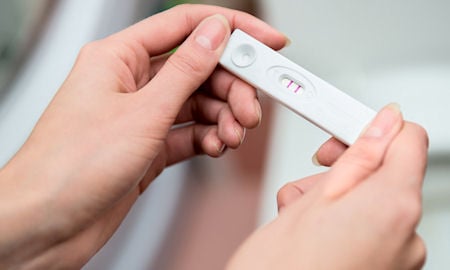
FAQs
Have questions about IVF and infertility? We have answers.
| Q: | Does ART damage the ovaries? |
| A: | There is little to no evidence to suggest that oocyte retrieval damages the ovaries; however, egg yield tends to decrease over time and medication requirements tend to increase with successive cycles. Whether this is a function of age or something involved with egg retrieval is uncertain. There is one report that suggests that infertile women who take fertility drugs and do not get pregnant have an increased risk of ovarian cancer. However, the study did not collect information on the type of drugs used, and the control (comparison) population may not have been selected accurately, since infertile women are known to carry an increased risk of ovarian cancer. The fertility drugs used in ART have been in use for more than 30 years, and other studies have suggested no increased risk. In most cases, the age of menopause does not appear to be altered after ovarian stimulation. |
| Q: | Why is the success rate with ART so low? |
| A: | Normal success rate for human reproduction is only 20 percent per month, which to many seems low. ART enables couples with lower than normal chances to match or surpass the normal rate for conception. Fortunately, over time and with the right treatments, the vast majority of couples suffering from infertility can become pregnant. |
| Q: | We're concerned about multiple births from ART. Should we just have one embryo transferred? |
| A: | Anytime more than one embryo is transferred, the chance for a multiple pregnancy exists. In fact, about 30 percent of births from ART are twins, a rate much greater than in the general population (1 in 80 pregnancies). Triplets and quadruplets have also been conceived through ART. However, the majority of ART pregnancies (nearly 70 percent) are singletons, and the chance of any pregnancy with ART increases up to a point with the number of embryos or oocytes transferred. Single embryo transfer should be considered as the preferred approach when a patient has favorable prognostic factors. Your physician can provide you with more information about this procedure. Identical twins can also occur with ART, the result of two babies from one egg, so even transferring only one embryo does not guarantee a singleton pregnancy. |
| Q: | Is there an increased chance of birth defects if I become pregnant through ART? |
| A: | The goal of IVF is to help you have a healthy baby. Overall, there does not seem to be an increased risk of birth defects in children conceived through IVF compared to those who conceive naturally. Because ICSI is a relatively new technique, first performed in 1992, long-term data concerning future health and fertility of children conceived with ICSI are not available. Naturally conceived children have a 3 percent-to 5 percent-risk of birth defects, and most reports on birth defects of children conceived through IVF-ICSI show similar rates. However, some studies of babies conceived through ICSI report an increased incidence of rare defects (<1 percent of children born from IVF-ICSI) known as imprinting disorders (including Beckwith-Wiedemann and Angelman syndromes), a congenital malformation called hypospadias (with the urethra, the opening for urine and semen, found on the underside instead of on the end of the penis), or sex chromosome abnormalities. This is an area of ongoing investigation in many countries. Because some causes of male infertility run in families and are related to genetic problems, male offspring might have reproductive problems as adults. Despite these concerns, ICSI is a major advance in the treatment of severe male infertility for couples who otherwise would be unable to achieve pregnancy. Chromosome abnormalities, such as Down's syndrome also occur at a rate similar to the general population. Patients considering IVF and ICSI are encouraged to discuss these issues with their ART provider and to review the clinic's consent form. |
| Q: | I had my tubes tied (tubal ligation) several years ago. Would I be a candidate for IVF? |
| A: | Yes, one has a choice of either surgical reversal of tubal sterilization or IVF. The choice depends upon the woman’s age, additional factors affecting fertility, how many pregnancies are desired, and cost. Tubal reversal is a good choice for women under 35 years old without other fertility factors who desire more than one baby. IVF is better for older women, and in couples with male factor infertility or who desire to maintain their contraception after the pregnancy. If ligation reversal has been attempted and has failed, IVF-ET represents the best option. Cost and other factors (such as type and location of the ligation) involved in surgical reversal should be discussed with your physician when making this decision. |
| Q: | Does insurance cover the procedure? |
| A: | Unfortunately, in most states, most insurance plans do not cover ART procedures. Some insurance policies cover portions of the therapy. The IVF staff can help you determine your level of coverage. It is strongly recommended you investigate what your insurance covers prior to starting ART therapy. |
| Q: | How many days does the entire procedure take? |
| A: | The entire procedure takes approximately five to six weeks. However, we only need to see you intensively over a two-week period. These details are discussed in the "Step by Step" sections. |
| Q: | Can we have intercourse while attempting ART? |
| A: | Yes. We recommend that the man abstain from ejaculating for at least 48 hours preceding egg retrieval. This precaution assures that the semen sample for ART is of optimal quality. Near the time of egg retrieval, the ovaries can be enlarged and tender, which can make intercourse uncomfortable. |
| Q: | What if I ovulate before the retrieval? |
| A: | Virtually all cases of premature ovulation are now prevented by the use of GnRH analogs (Lupron®, Synarel®, Cetrotide® or Antagon®) or GnRH antagonists. |
| Q: | Will scar tissue around my ovaries make it impossible to retrieve oocytes? |
| A: | No, the oocyte can usually be retrieved by transvaginal aspiration even when the ovaries are covered with scar tissue. In rare cases, scarring pulls the ovaries out of the normal pelvic position. This condition can be identified with ultrasound before ART is undertaken, and an alternative method of obtaining eggs used. |
| Q: | How much activity is recommended after ET? |
| A: | It is controversial how much, if any, deduced activity is needed after embryo transfer. Some programs suggest routine activity immediately after ET; others suggest that patients avoid strenuous exercises, running, etc. until a pregnancy test has been performed. Still others suggest their patients have bed rest for 24–48 hours after ET. |
| Q: | After embryo transfer, how long must we wait until we have intercourse without risk to the embryo? |
| A: | No one knows for sure. Patients should ask their doctor for advice on this topic. |


